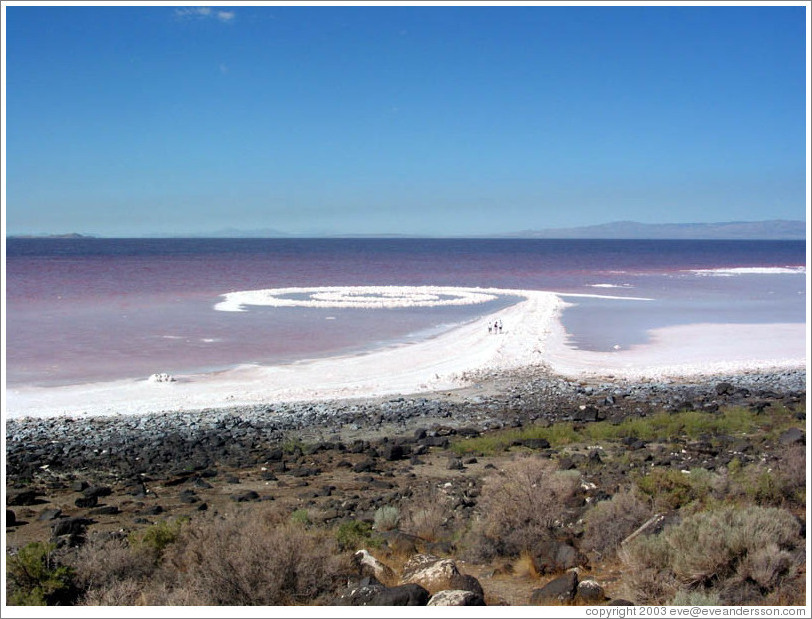

Now in the collection of the New York DIA Center of the Arts, the condition of Spiral Jetty is being documented by DIA since its reappearance. Spiral Jetty lives at Rozel Point, Great Salt Lake Robert Smithson dreamed it and made it. Since then, water level fluctuations have allowed episodic re-emergences. Rising water levels caused the earthwork to be submerged just a few years after its completion, remaining as such until the 1990s. Jutting out into the red-tinted water of the northeastern shore of the Great Salt Lake, Spiral Jetty comprises 6,000 tons of black basalt, earth, and salt crystals. Constructed at an elevation of 4,195 feet, it was intended to appear and disappear as the lake’s water level varied. The design reflects Smithson’s interest in entropy and was influenced by the physical nature of the site which suggested the spiral form. Originally very dark rock against reddish water, salt encrustations have created a much whiter form against pink-hued water. Artist Robert Smithson created Spiral Jetty in April 1970 and later donated the earthwork art to the Dia Center for the Arts in New York. Made of black basalt rocks and earth gathered from the site, Spiral Jetty is a 15-foot-wide coil that stretches more than 1,500 feet into the lake. Smithson was attracted to this remote location by the landscape’s stark qualities, abandoned industrial relics, and the presence of red-tinged algae which grows in the otherwise lifeless northern arm of the salt lake. The monumental earthwork Spiral Jetty (1970) was created by artist Robert Smithson and is located off Rozel Point in the north arm of Great Salt Lake. The 1,500-foot long counter-clockwise spiral, built of earth, basalt rock, and precipitated salt crystal, reaches out into the Great Salt Lake near Rozel Point, Utah.

Together with the film, some drawings and photographs of Smithson are also on display.This earthwork, designed by the artist and sculptor Robert Smithson in 1970, is an icon in the field of land art.

His plan, he wrote on his application to the Utah Division of State Lands, was to induce salt crystals on the rock and gravel as incrustations that will develop over a period of time.

Spiral jetty is one of the most significant representations of land art, a movement that gained impetus in the 1960s and 1970s in which artists made large-scale works of art in and with the landscape itself. Written By Elaine Jarvik Spiral Jetty itsthuytime One day in the spring of 1970, Robert Smithson plunked down 100 to lease 10 desolate acres of brine and rocks. In other words, Spiral jetty can be experienced in three different ways: while reading the text, by visiting the jetty itself, or by watching the film, as it is done here. He came upon Rozel Point, a remote area in the north arm of Utah’s Great Salt Lake that blooms in pinks and oranges, thanks to an ever-fluctuating community of microbes in the salty waters. The Bulgarian-born artist Christo has involved large. The film, together with the article ‘The Spiral Jetty’ that Smithson published in 1972, and Spiral jetty itself, form the complete work. extend a rock and dirt spiral, 1,500 feet (460 m) long, into Great Salt Lake in Utah (Spiral Jetty 1970). He even rented a helicopter to be able to film the construction from the air. Robert Smithson (Janu July 20, 1973) was an American artist known for sculpture and land art who often used drawing and photography in relation to the spatial arts. From the very start Smithson captured on film how the lorries, bulldozers, and tractors built this construction of approximately 480 cm wide and 480 metres long in the water at Rozel Point. Robert Smithson, Spiral Jetty in 2004, Rozel Point, Great Salt Lake, Utah. In spring 1970 Smithson installed a spiral jetty in the Great Salt Lake in Utah made of 6,550 tonnes of earth, black basalt, limestone, and gravel.


 0 kommentar(er)
0 kommentar(er)
